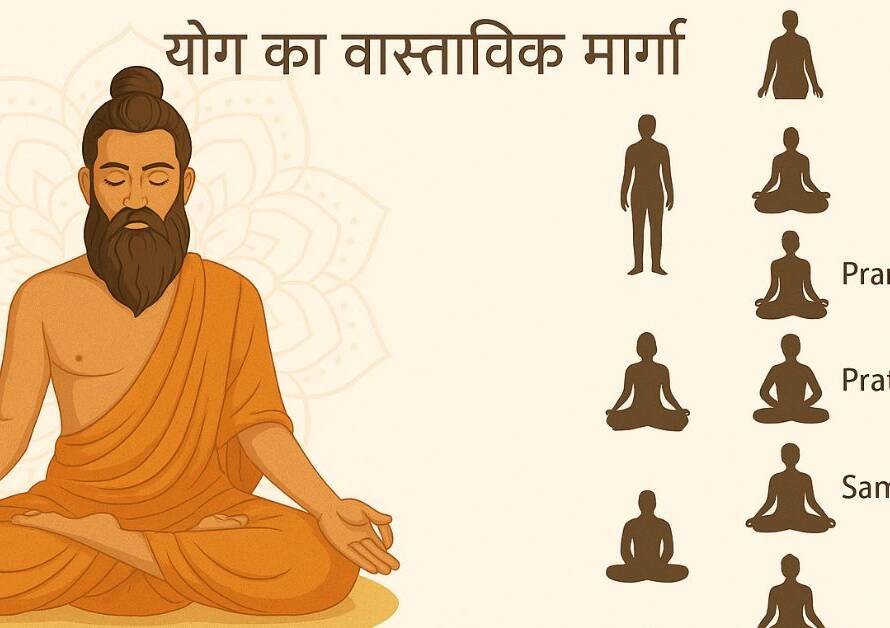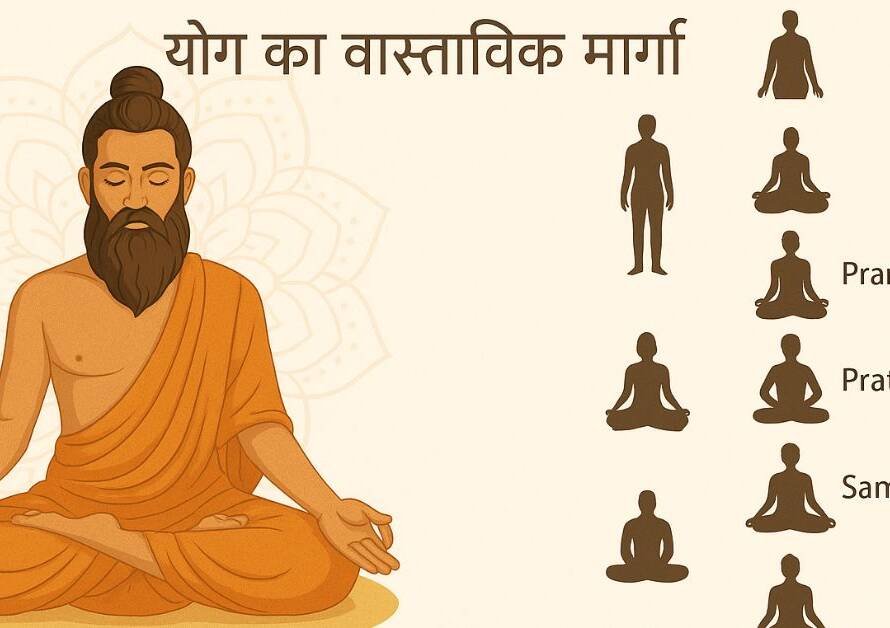Today, yoga is globally recognized as a system for physical health, mental peace, and overall well-being. Unfortunately, the modern approach and commercialization have reduced yoga to merely a few physical postures (asanas), breath control (pranayama), and meditation, focusing solely on good health. However, Patanjali’s Ashtanga Yoga offers a much deeper and holistic path that encompasses ethical living, inner discipline, and spiritual growth beyond just physical practices.
- Yoga today is globally recognized as a system for physical fitness, mental peace, and general well-being.
- But thie modern perception and commercialization has unfortunately reduced it to just a set of postures (āsanas) and breathing exercises (prāṇāyāma).
- The truth is: Yoga, especially as presented by Maharishi Patanjali in his Yoga Sutras, is a deep, disciplined spiritual science meant to purify the mind, regulate the senses, and ultimately lead to liberation (moksha).
Patanjali’s Yoga is not merely a health regimen, but a path to God-realization — the highest purpose of human life.
The Eight Limbs of Ashtanga Yoga (अष्टाङ्ग योग)
- Patanjali described the path of Yoga as having eight steps, like the rungs of a ladder
- each one preparing and supporting the next. You cannot skip steps and expect true transformation.
- Mastery of each stage is essential for the next to bear fruit. These steps are:
1. Yama (यम) – Restraints / Moral Disciplines
These are the universal ethical codes that help purify and regulate external behavior and interpersonal conduct. They are:
- Ahimsa (Non-violence)
- Satya (Truthfulness)
- Asteya (Non-stealing)
- Brahmacharya (Sense control)
- Aparigraha (Non-possessiveness)
Without mastering these, inner purity remains impossible. Sadly, today’s commercial yoga culture completely ignores them.
2. Niyama (नियम) – Personal Observances
These are disciplines that help regulate and uplift your internal life and personal habits:
- Shaucha (Purity)
- Santosha (Contentment)
- Tapas (Austerity, self-discipline)
- Swadhyaya (Study of scriptures & self-reflection)
- Ishwar Pranidhana (Surrender to God)
Together with Yama, Niyama lays the foundation for mental and spiritual discipline. But modern yoga practices bypasse these entirely, rushing toward āsanas and prāṇāyāma and dhyana.
3. Asana (आसन) – Steady Posture
- The original purpose of āsana was not fitness or flexibility, but to develop a steady and comfortable sitting posture for long meditation sessions. Patanjali says:
- “स्थिरसुखमासनम्” (sthira-sukham-āsanam)— The posture should be steady and pleasant.
- The flood of postures taught in yoga studios is more about physical training, not spiritual awakening. True āsana practice is about training the body to serve the soul.
4. Pranayama (प्राणायाम) – Breath Regulation
This step involves controlling the prāṇa (vital energy) through breathing techniques. It calms the mind, removes restlessness, and prepares you for meditation. However, without mental purity (Yama & Niyama), prāṇāyāma can agitate the system and cause harm.
5. Pratyahara (प्रत्याहार) – Withdrawal of the Senses
Here, the senses are consciously withdrawn from worldly attractions. The mind stops chasing pleasure through the senses. It’s like a turtle withdrawing its limbs — a preparation for deeper inner work.
“Indriya Nigrah” (Sense control) is the first real sign of spiritual maturity.
6. Dharana (धारणा) – Concentration
This step teaches the mind to focus on one point — be it a mantra, the image of a deity, or the breath. Without earlier purification, concentration will constantly break. This is the beginning of deep meditation.
7. Dhyana (ध्यान) – Meditation
Meditation is uninterrupted flow of concentration. Here, the ego begins to dissolve, and the soul connects with the Divine. True meditation cannot happen until the mind is purified, senses withdrawn, and concentration established. Hence, jumping directly to meditation, as seen in popular teachings, is like building a roof without walls.
8. Samadhi (समाधि) – Absorption / Divine Union
This is the final goal — a state where the individual ego vanishes, and the soul becomes one with the Supreme (Ishwar). In this state:
- All dualities cease.
- The mind becomes absolutely still.
- The yogi realizes his true nature as Atman (soul), and attains liberation.
The Core Objective: Chitta Vritti Nirodha (चित्तवृत्ति निरोध)
- The entire purpose of yoga is defined in Patanjali’s second sutra:
- “योगश्चित्तवृत्तिनिरोधः” Yoga is the cessation of the fluctuations (vrittis) of the mind (chitta).
- All eight limbs exist only to lead the seeker to this ultimate inner stillness, where the mind no longer swings between desires, fears, or distractions
- and instead, focuses solely on God. This alone leads to moksha, the freedom from birth and death.
A Warning Against Modern Commercialization
Today, yoga is being sold as a wellness product. Teachers jump straight to:
- āsanas for weight loss,
- prāṇāyāma for stress relief,
- or even direct “samādhi” promises through workshops.
This is a gross misrepresentation of the true yogic path. Ignoring Yama and Niyama is like pouring water into an unclean vessel — the effort is wasted, and even dangerous.
The True Path of Yoga
- Yoga is not about touching your toes; it’s about touching your soul.
- Ashtanga Yoga is a divine ladder that can elevate a seeker from restlessness to realization, from bondage to bliss. But this requires patience, discipline, and surrender — not shortcuts.
- Let us return to the authentic roots of Sanatana Dharma. Let us reclaim Yoga as a sacred journey to unite the soul with God
- not just as an exercise routine. Let us walk each step with devotion, dedication, and right knowledge.
🇮🇳Jai Bharat, Vandematram 🇮🇳
For more blogs please visit www.saveindia108.in
👉Join Our Channels👈







